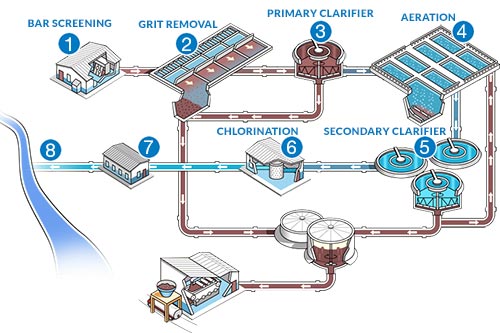Next-Generation Technologies for Efficient Wastewater Recycling
Next-Generation Technologies for Efficient Wastewater Recycling
Blog Article
Understanding Wastewater Treatment Processes and Their Ecological Impact
The complexities of wastewater therapy procedures play a crucial function in mitigating ecological difficulties linked with water contamination. Each phase, from preliminary to sophisticated therapies, is developed to resolve specific pollutants, inevitably protecting both public wellness and marine ecosystems. In spite of technical innovations in treatment efficiency, considerable difficulties linger, consisting of the management of residual contaminants and the ramifications of nutrient overflow. As we discover the intricacies of these processes, it becomes vital to wonder about just how much current methodologies can develop to satisfy the growing needs of sustainability and ecological conservation.
Review of Wastewater Therapy
How is wastewater transformed into a safe source for the setting? Wastewater therapy is an important procedure created to remove impurities from made use of water, therefore guarding public health and wellness and securing ecological communities. This procedure starts with the collection of wastewater from property, commercial, and industrial sources, which is after that routed to treatment centers.
At these centers, various physical, chemical, and biological techniques are utilized to deal with the wastewater. First testing removes huge particles, complied with by sedimentation to different larger solids. Consequently, biological therapies, such as activated sludge processes, make use of microorganisms to break down raw material. These approaches not just decrease pollutant degrees however also promote the healing of beneficial nutrients.
The treated effluent can be securely discharged right into all-natural water bodies or recycled for watering and commercial functions, promoting resource conservation. In addition, the treatment procedure creates biosolids, which can be repurposed as fertilizers or soil modifications, even more boosting sustainability.
Phases of Treatment Procedures
The wastewater therapy procedure generally includes three main phases: preliminary, primary, and second therapy. Each stage serves a distinctive role in reducing the contaminant lots and making certain the effluent satisfies environmental requirements before discharge.

The main therapy phase concentrates on the physical separation of put on hold solids from the wastewater. With sedimentation, heavier fragments settle at the base of sedimentation storage tanks, creating sludge, while lighter products, such as oils and greases, float to the surface and are skimmed. This procedure substantially decreases the natural and inorganic tons in the wastewater.
Secondary treatment is an organic procedure aimed at further minimizing the concentration of natural matter. This stage is essential for achieving the necessary biochemical oxygen need (FIGURE) reduction, eventually leading to cleaner effluent all set for discharge or more therapy.

Advanced Therapy Technologies
Complying with the additional treatment procedures, advanced treatment modern technologies play a vital function in further improving the quality of treated wastewater. These innovations are created to eliminate residual impurities that are not successfully eliminated during main and second therapies, guaranteeing the effluent satisfies stringent regulatory requirements.
Among the commonly used innovative treatment approaches are membrane filtering, reverse osmosis, and progressed oxidation processes. Membrane layer filtering, including microfiltration and ultrafiltration, is effective in dividing fine bits, microorganisms, and colloids from the water (Wastewater). view Reverse osmosis makes use of semi-permeable membranes to get rid of dissolved solids, leading to high-grade water appropriate for numerous applications
Advanced oxidation processes (AOPs) employ solid oxidants to deteriorate organic pollutants, consisting of pharmaceuticals and individual care products that are immune to standard therapy. These approaches enhance the biodegradability of complex compounds, promoting their removal.
Another considerable modern technology is making use of biological nutrient elimination procedures, which particularly target nitrogen and phosphorus, preventing eutrophication in receiving water bodies. On the whole, innovative therapy modern technologies are necessary for accomplishing greater degrees of filtration, promoting water reuse, and protecting public health and wellness while addressing the challenges connected with wastewater click for more info administration.
Ecological Benefits of Treatment
Countless ecological advantages occur from effective wastewater treatment procedures that add to ecosystem health and sustainability. Largely, these processes dramatically reduce the release of damaging toxins right into natural water bodies, which helps preserve aquatic ecological communities. By getting rid of contaminants such as heavy metals, nutrients, and pathogens, treated wastewater minimizes the threat of waterborne conditions and advertises biodiversity in marine settings.
Moreover, wastewater therapy facilities usually utilize innovative technologies that allow water recycling and reuse. This method not only preserves fresh water resources however additionally decreases the demand on all-natural water materials. Boosted nutrient elimination from wastewater can additionally stop eutrophication, a procedure that brings about algal blossoms and succeeding oxygen depletion in marine systems.
In addition, efficient therapy processes can reduce greenhouse gas emissions, particularly methane and laughing gas, which are commonly launched throughout without treatment wastewater decomposition. By capturing and making use of biogas from anaerobic digesters, facilities can transform waste right into renewable resource, therefore adding to a reduction in nonrenewable fuel source dependence.
Challenges and Future Fads
While the environmental advantages of wastewater therapy are clear, numerous obstacles continue that impede ideal end results in this field. One major issue is maturing infrastructure, which commonly brings about ineffectiveness and boosted functional expenses - Wastewater. Several therapy plants were made decades ago, and their capabilities do not align with contemporary demands, which include more stringent regulative requirements and greater quantities of wastewater due to urbanization

Looking ahead, there is a growing focus on source healing and circular economic situation concepts within wastewater therapy. Developments such as anaerobic food digestion, which can you can try this out create biogas, and progressed filtering modern technologies are getting traction. These approaches not just boost treatment effectiveness yet also promote sustainability.
Eventually, addressing these obstacles calls for collaboration amongst stakeholders, investment in technology, and a commitment to ongoing research. By accepting these fads, the wastewater therapy sector can evolve to meet the needs of a transforming atmosphere and society.
Final Thought
In conclusion, wastewater therapy processes play a crucial role in boosting environmental high quality and public wellness. The multi-stage treatment structure, combined with sophisticated modern technologies, efficiently reduces air pollution and promotes lasting water monitoring.
Report this page